A Global Crisis
The Academic Reality in Switzerland: Years of Fixed-Term Contracts
Imposed Part-Time Employment, Disguised Full-Time Work
The Complexity of Funding in Swiss Academia
A Global Crisis
Around the world, students and staff are protesting low-salaries, heavy workloads leading to overwork and burnout, job insecurity, pay-cuts, neo-managerial evaluation and the climate of fierce competition in third-party funding for research projects.
The advent of the neoliberal surge has put numerous sectors, including higher education, under pressure. In France, students began to strike in November 2019 after the immolation of a union member who wrote a letter denouncing student poverty and living conditions. These strikes expanded in December and included vocal protests against Antoine Petit, the CEO of CNRS, after he openly declared he supported an ‘in-egalitarian’ and ‘darwinian’ income law for research and more and more generally against the project of ‘La loi de programmation pluriannuelle de la recherche’ (LPPR).
UK colleagues have been fighting for their pension, against underpayment and for better work conditions for years, while Dutch universities now face inspections over “structural overtime”. This summer, Australia’s top Universities have acknowledged that they have saved tens of millions by underpaying staff. They have now pledged to pay back academics for underpayments stretching back a decade. Many more examples can be find on our resources page.
What does precarious work mean? This term (also called contingent, atypical, non-standard work, travail inadéquat, etc.) has been increasingly used to describe the social reality of a fast growing number of employees, but has no international, sometimes even no national (as is the case in Switzerland), standard definition, rendering the quantification and thus the analysis of the phenomenon difficult.
Since the 1990s, employers have taken increasing recourse to what can be called flexible work arrangement and imposed part-time. The changes are leading to the disappearance of long-term wage relationship and the security connected to a stable job perspective.
Many organizations, first and foremost the International Labour Organization (ILO) but also trade unions, think tanks and academics are working on this problem and on an international standardization of this concept.
For the ILO, precarious work is “work performed in the formal and informal economy and is characterized by variable levels and degrees of objective (legal status) and subjective (feeling) characteristics of uncertainty and insecurity. Although a precarious job can have many faces, it is usually defined by uncertainty as to the duration of employment, multiple possible employers or a disguised or ambiguous employment relationship, a lack of access to social protection and benefits usually associated with employment, low pay, and substantial legal and practical obstacles to joining a trade union and bargaining collectively.”
International Labour Office, Bureau for Workers’ Activities, From Precarious Work to Decent Work. Outcome Document to the Workers’ Symposium on Policies and Regulations to Combat Precarious Employment, Geneva, International Labour Organization, 2012, p. 27.
Neoliberal pressure on our higher education institutions has consequences on both the quality of research and on the quality of life of everyone. This has been even further exacerbated by the global pandemic. For the well-being of us and the universities, this needs to change.
spacespacespace
The Academic Reality in Switzerland: Years of Fixed-Term Contracts
Researchers in Switzerland face increasingly precarious working conditions that impact both their health and the quality of their work. In the current academic system, only chaired professors have permanent positions (with few exceptions); the huge majority of employees are on fixed-term contracts. This is especially the case for the more than 40,000 people who belong to the mid-level academic staff[1] known in French as corps intermédiaire and in German as Mittelbau (intermediate staff), which includes doctoral students, post-doctoral researchers, teaching staff, and scientific collaborators.
The excellence of scientific research in Switzerland depends heavily on the labor of this highly skilled workforce. Without the work performed by this intermediate staff, research and teaching would not be possible, as only 10% of all academic employees in Switzerland are professors. For the university, a doctoral candidate means significant contributions to the research and teaching output, and can also include central administrative tasks. Thus, high numbers of PhD students are not only important for international rankings, these employees allow the universities to fulfill their politically mandated duties of teaching and research.

Schweizerische Akademie der Geistes- und Sozialwissenschaften (2018), Next Generation: Für eine wirksame Nachwuchsförderung, Swiss Academies Reports, 13 (1), p. 17.
The average age for completing a doctorate is 31-37 years. This means that the beginning of the postdoc phase coincides with the question of family planning. In this situation, significantly more women than men decide against an academic career. Those who remain in academia, will face another decade of precarious employment, as most only receive a professorship well into their 40s. Of any given cohort of PhDs, only 9% percent have receive a permanent, tenured position.[2]
“Das Ende der Postdoc-Phase wird mit einem Ruf auf eine unbefristete Professur erreicht. Zu diesem Zeitpunkt sind die Wissenschaftlerinnen und Wissenschaftler durchschnittlich deutlich älter als 40 Jahre. Bis dahin hangeln sich die meisten Postdocs von einer befristeten Finanzierung zur nächsten. Gleichzeitig leisten sie bereits vor ihrer Berufung hoch spezialisierte Arbeit, die sich teilweise kaum von der Arbeit von berufenen Professorinnen und Professoren unterscheidet.”
Schweizerische Akademie der Geistes- und Sozialwissenschaften (2018), Next Generation: Für eine wirksame Nachwuchsförderung, Swiss Academies Reports, 13 (1), p. 40.
The employment of mid-level academic workers is characterized by successive fixed-term contracts (usually part-time and at best for a few years, sometimes for a few months) as well as insufficient income, lack of autonomy in planning, dependence on individual professors, and bleak prospects of ever attaining a permanent academic position.
In the following graphs, the lack of permanent positions in Switzerland becomes especially apparent in comparison to other countries:
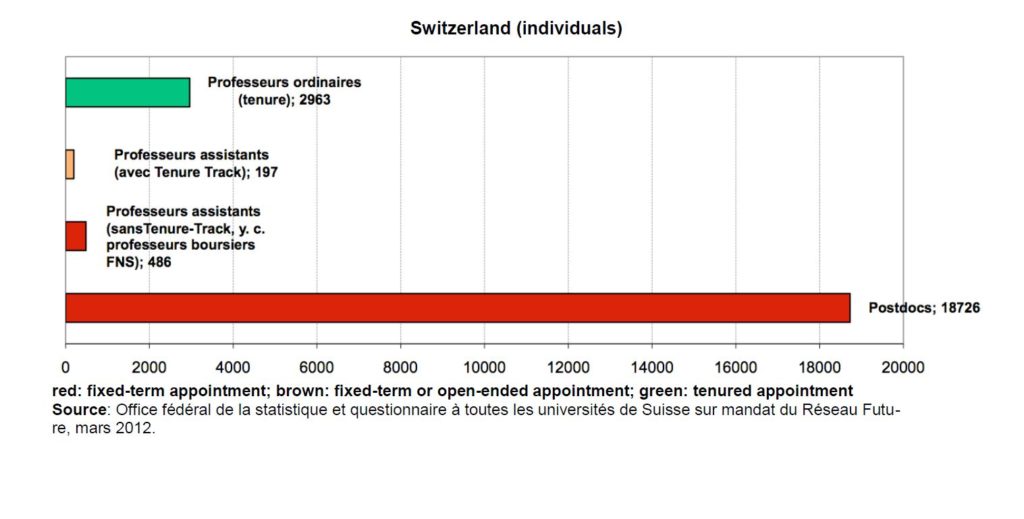
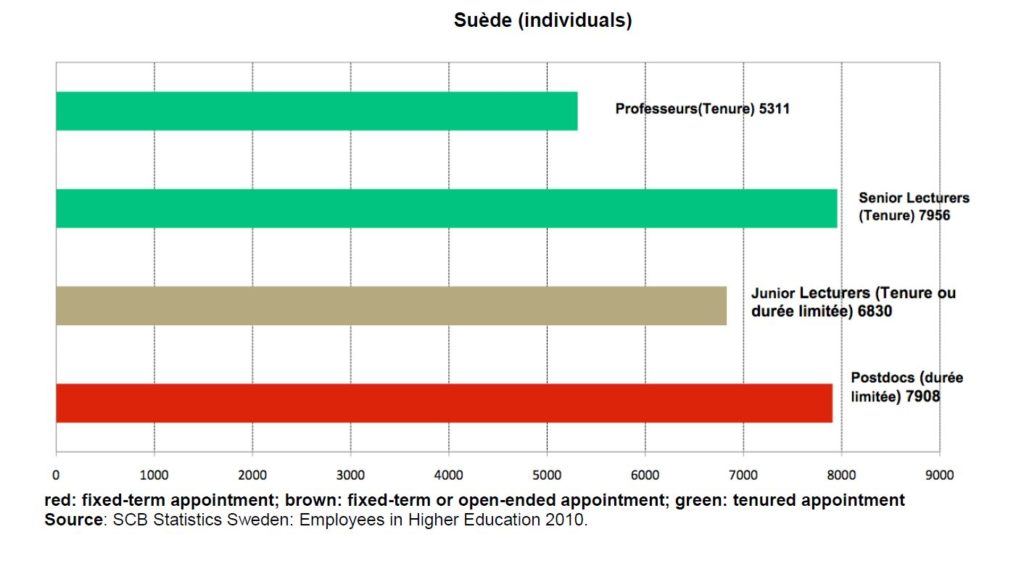
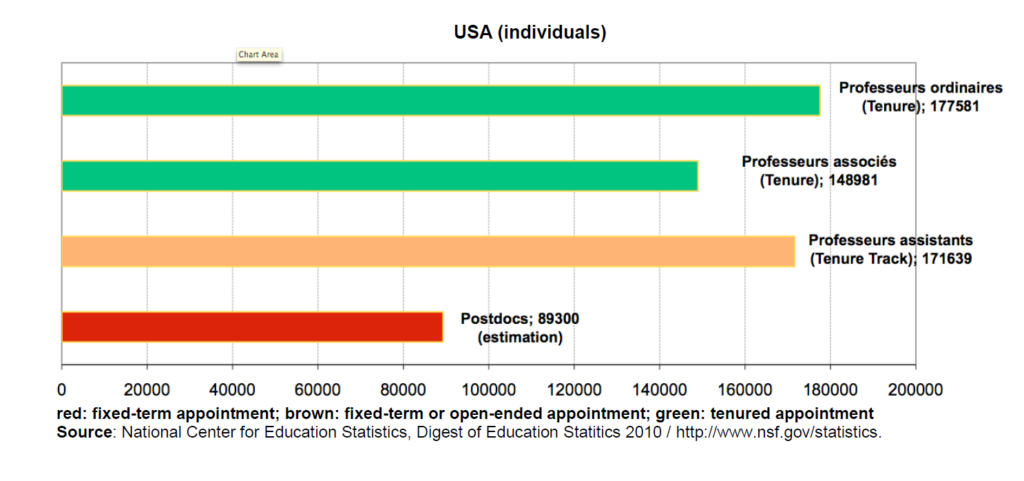
VISION 2020: Prise de position des jeunes chercheurs [position paper by young scholars]; hearing of the CSEC-E, April 2012.
The result is a squandering of human resources in academic departments because of burnouts, interrupted research projects, and abandonment of academic careers.
Associations representing mid-level academic staff have been sounding the alarm for years. Yet these calls have not led to any significant reform.
“Déjà en 2012, un cahier des doléances avait été présenté aux États généraux de la recherche à Lausanne. Il pointait les problèmes suivants:
– La précarité financière des chercheur·es;
– La quantification de la recherche et la compétition accrue entre les chercheur·es,
– La hiérarchie au sein de l’université;
– L’atrophie des activités d’enseignement au profit de celles de la recherche;
– La perte du sens des objets étudiés par la recherche.
Des questions qui sont encore d’une criante actualité car, en 2019, les statistiques montrent que huit chercheur·es sur dix sont sans contrat fixe dans les universités suisses. Ainsi, et en allant encore plus loin, selon l’hebdomadaire WOZ ‘ce sont les 90% du personnel qui assurent le fonctionnement de l’académie’.”
(from: Biaggio, Christina del. (2020) Comprendre le néolibéralisme universitaire français à partir de la Suisse. Revue Internationale d’Urbanisme).
As Antonio Loprieno, member of the Board of the University of Zurich, conceded in an NZZ am Sonntag article in February this year:
“Das System ist zwar für den Einzelnen brutal, aber es lässt sich nicht leicht verbessern.”
(from: Antonio Loprieno in an Interview with René Donzé. “Forschende der Universität Zürich fühlen sich ausgebeutet”. NZZ am Sonntag, 15.02.2020)
The claim that it is difficult, however, is not a good enough reason to not start working on changing the system. Brutality and cruelty is not a productive environment for research and higher education in Switzerland. We have to do better.
[1] number based on: BFS (2020). Personnel des hautes écoles universitaires 2019 (Table 5c). Our number includes Assistierende und wissenschaftliche Mitarbeitende, übrige Dozierende as well the midlevel staff at universities of applied sciences and arts (Fachhochschulen) and teacher education (Pädagogische Hochschulen).
[2] see BFS 2019. Personal der universitären Hochschulen 2018. (Table 1a). https://www.bfs.admin.ch/bfs/de/home/aktuell/neue-veroeffentlichungen.gnpdetail.2019-0031.html
spacespacespace
Imposed Part-Time Employment, Disguised Full-Time Work
In addition to fixed-term contracts and the resulting job insecurity (and life planning insecurities over a decade and longer), mid-level academic work is furthermore characterized by systemic part-time employment often with the expectation (implicit or explicit) of full-time work.
Whereas 4/5 of professors are employed on 90% or higher and on tenured (for life) contracts, the reality for the rest of the academic staff looks very different in Switzerland:
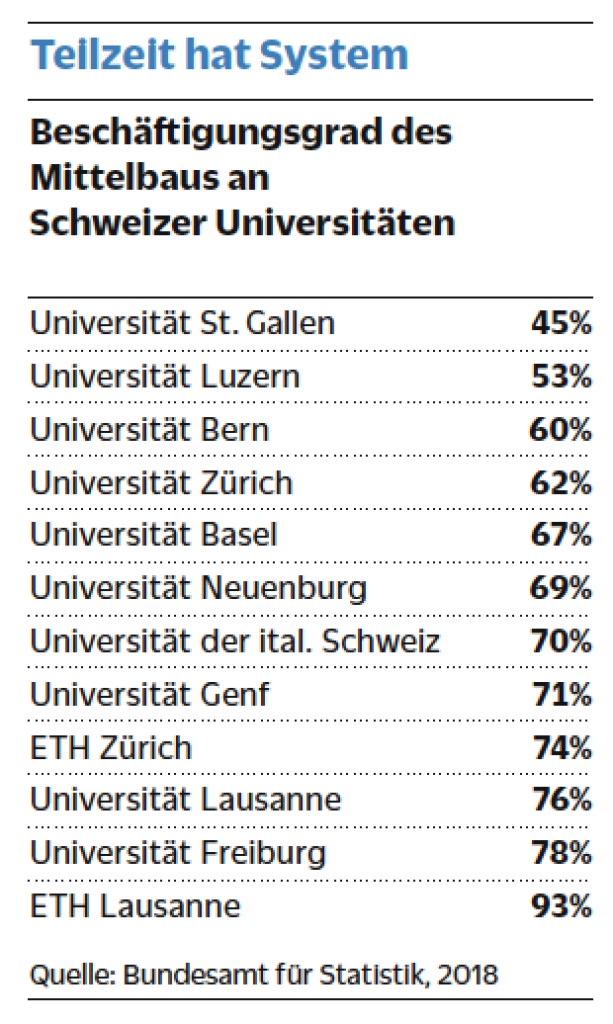
René Donzé. “Forschende der Universität Zürich fühlen sich ausgebeutet”. NZZ am Sonntag, 15.02.2020
This, however, also has significant consequences for the salary of mid-level academic staff. With the result that much of the highly specialized research and teaching at higher education institutions is literally being subsidized by mid-level academic staff.
And since these conditions are often the reality for many for a decade or longer, crucial social security benefits such as pensions (AHV/AVS and IV/AI) are likewise impacted, which can hardly be mitigated unless one belongs to the lucky 9% who will receive a tenured professorship and the accompanying high salary.
The researchers Janine Rodgers and Gerry Rodgers characterization of precarious labor from 1989 is still valid today and especially foregrounds the following aspects and impacted areas:
Temporal – low certainty regarding the continuation of employment
Organisational – lack of workers’ individual and collective control over working conditions, working time and shifts, work intensity, pay, health and safety
Economic – poor pay (insufficient pay and salary progression)
Social – legal, collective or customary protection against unfair dismissal, discrimination, and unacceptable working practices; and social protection (access to social security benefits covering health, accidents, unemployment insurance)
Rodgers, Gery, Rodgers, Janine, Precarious jobs in labour market regulation: the growth of atypical employment in western Europe, Bruxelles, International Institute for Labour Studies, Université libre de Bruxelles, 1989.
All these aspects hold true for the working conditions of mid-level academic staff.
In August this year, the editors (scientists from Switzerland, France, Canada, and Belgium) of Bulletin of Sociological Methodology/Bulletin de Méthodologie Sociologique published a special issue on precarity stating:
[T]he increasing precarity of teaching and research professions, which has been steadily increasing over the last 20 years, is inflicting serious damage on our profession both individual and collectively. This precarity is not the “price” that must be paid to enter a university career. It is not simply a matter of a series of postdocs and associate (or assistant) professor positions before finally obtaining the Holy Grail of tenure or a permanent contract, as the discourses […] might lead us to believe. […] Precarity is now a structural element in a sector where management strategies are more and more similar to those in other economic sectors.
In many OECD countries, regardless of the way higher education and research is organised, an increasing proportion of teaching is provided by employees on short term contracts (often limited to one university year, with no guarantee of employment after that), while the number of permanent or tenure teaching positions continues to decline steadily.
Balsiger P, Bodet M-A, Brugidou M, et al. Why a special issue on ‘precarity’? Bulletin of Sociological Methodology/Bulletin de Méthodologie Sociologique. 2020;147-148(1-2):8-12. doi:10.1177/0759106320939885a
spacespacespace
The Complexity of Funding in Swiss Academia
One of the difficulties in making changes are the many stakeholders involved. We are fully aware of the complexity. However, we need everyone involved to have this discussion now. This cannot be put off any longer. For the future of academia and for the excellence of scientific research in Switzerland, our universities have to act responsibly towards all their employees now.
Im Wissenschaftssystem der Schweiz sind mehrere Akteure für die Nachwuchsförderung in der Postdoc-Phase wichtig. Ihre Beiträge zur Ausgestaltung der Rahmenbedingungen sind
unterschiedlich; alle zusammen ergeben ein vielschichtiges Ganzes mit zugewiesenen Verantwortlichkeiten und Kompetenzen, teilweise koordiniert, teilweise mit widersprüchlichen Ausrichtungen. Entsprechend schwierig ist es, selbst bei geteilter Einschätzung der Probleme strukturelle Veränderungen zugunsten spezifischer Personengruppen voranzutreiben. Auf Stufe der Hochschulen und mit Blick auf die Nachwuchsförderung erleichtert der in der Schweiz gelebte Bildungsföderalismus die Entwicklung und Etablierung von griffigen und langfristig wirksamen Massnahmen kaum. Auf jeden Fall ist die Koordination anspruchsvoll und erfordert von allen Beteiligten ein klares Commitment.
Schweizerische Akademie der Geistes- und Sozialwissenschaften (2018), Next Generation: Für eine wirksame Nachwuchsförderung, Swiss Academies Reports, 13 (1), p. 31.
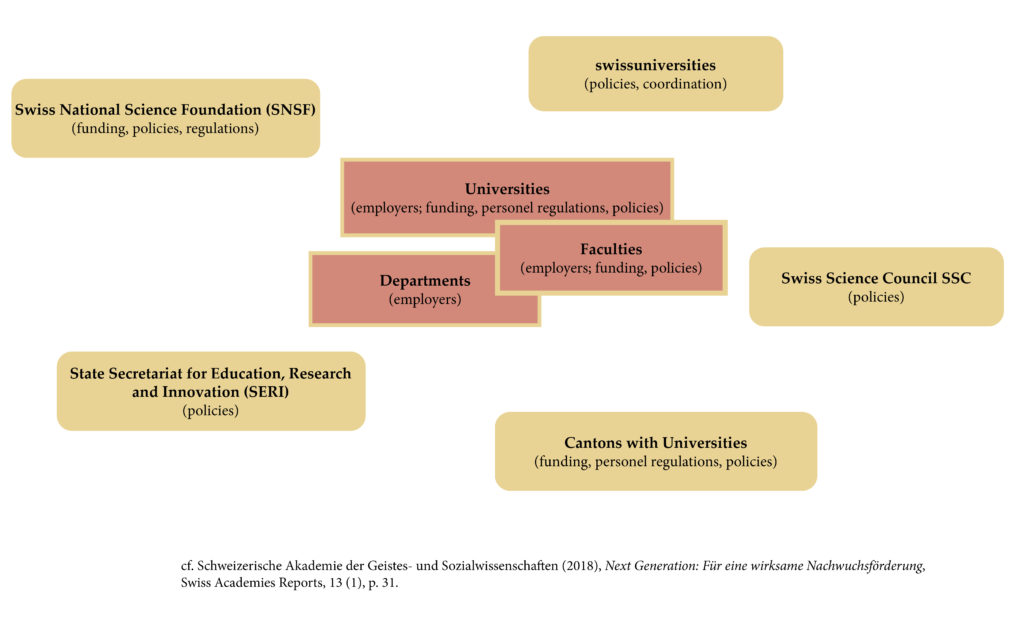
Die Stellenstruktur hat mit dem stark gestiegenen Leistungsumfang der Universitäten nicht Schritt gehalten. Der stark gewachsenen Anzahl an Studierenden, den vielfältigen Aufgaben in der Nachwuchsförderung und den neuen Anforderungen an Management und Rechenschaftsablage wurde bislang erst teilweise durch einen Ausbau von unbefristeten Stellen im wissenschaftlichen Bereich Rechnung getragen. Hier besteht anden Universitäten klar Nachholbedarf.
Schweizerische Akademie der Geistes- und Sozialwissenschaften (2018), Next Generation: Für eine wirksame Nachwuchsförderung, Swiss Academies Reports, 13 (1), p. 61.
In 2012, a group of Swiss academics including both professors and mid-level staff drafted a document entitled “Vision 2020” where they pointed out the risks for the excellence of the Swiss Higher Education sector if no fundamental changes to the structures are being made:
VISION 2020: Sans une restructuration profonde des hiérarchies universitaires, la Suisse devra acheter la plus grande part de ses élites à l’étranger.
Les hautes écoles suisses sont excellentes dans la recherche mais forment trop peu de spécialistes pour l’économie et peinent à recruter et à encourager les talents scientifiques issus du système de formation helvétique. Si la Suisse veut éviter de devoir importer ses élites de l’étranger dans quelques années, il faut entreprendre des réformes radicales.
VISION 2020: Prise de position des jeunes chercheurs [position paper by young scholars]; hearing of the CSEC-E, April 2012.
Now it is 2020 and we can well say that not much has changed and the situation has been excacerbated with the economic realities of the last decade and now aggravated by the COVID-19 crisis, clearly revealing once again the fragility of these jobs and the vulnerability of the researchers. Back in 2012, the researchers proposed three concrete measures to alleviate the situation and to ensure the competitiveness of Swiss higher education:
1. la création, d’ici à 2020, de mille postes de professeurs assistants dans les universités suisses (EPF incl.) avec l’option d’un engagement à durée indéterminée (Tenure Track);
2. la réorganisation des études doctorales avec un encadrement pluridisciplinaire systématique, plus de temps pour la recherche
et une rémunération adaptée (CHF 4000.- net par mois minimum);
3. la mise en place d’instruments pour soutenir et décharger les chercheuses avec des enfants et sans poste fixe.
VISION 2020: Prise de position des jeunes chercheurs [position paper by young scholars]; hearing of the CSEC-E, April 2012.
Not one of these measures has been implemented in the last 8 years. In fact, one of the solutions that has been circulating for years now is the creation of tenure track assistant professor positions (TTAP). According to the State Secretariat for Education, Research and Innovation policy plan (FRI) 2017-2020, the goal was to create a modest 160 TTAP by 2020 (p. 2999 of the FRI). This goal does not seem to have been met. Data from the Federal Statistics Office does not specify professorships by type, but only 120 professorships in total were added by Swiss universities between 2017 and 2019 (see Tables 5c of each year). And the new FRI 2021-2024 simply says that Assistant Professor Positions ‘were created’, without providing any further numbers, thus not even allowing the general public to assess the strategy.